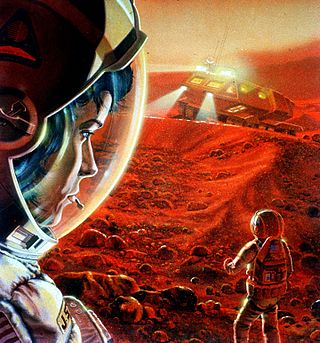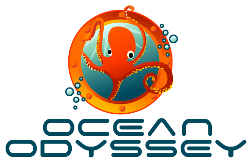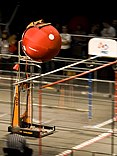The Mars Society is a nonprofit organization that advocates for human Mars exploration and colonization. It was founded by Robert Zubrin in 1998 and based on Zubrin's Mars Direct philosophy, which aims to make human mission to Mars as lightweight and feasible as possible. The Mars Society aims to generate interest in the Mars program by garnering support from the public and lobbying. Many Mars Society members and former members are influential in the wider spaceflight community, such as Buzz Aldrin and Elon Musk.

The Mars 2 was an uncrewed space probe of the Mars program, a series of uncrewed Mars landers and orbiters launched by the Soviet Union beginning 19 May 1971. The Mars 2 and Mars 3 missions consisted of identical spacecraft, each with an orbiter and an attached lander. The orbiter is identical to the Venera 9 bus. The type of bus/orbiter is the 4MV. They were launched by a Proton-K heavy launch vehicle with a Blok D upper stage. The lander of Mars 2 became the first human-made object to reach the surface of Mars, although the landing system failed and the lander was lost.

Mars Science Laboratory (MSL) is a robotic space probe mission to Mars launched by NASA on November 26, 2011, which successfully landed Curiosity, a Mars rover, in Gale Crater on August 6, 2012. The overall objectives include investigating Mars' habitability, studying its climate and geology, and collecting data for a human mission to Mars. The rover carries a variety of scientific instruments designed by an international team.

The FIRST LEGO League Challenge is an international competition organized by FIRST for elementary and middle school students.

The Aurora programme was a human spaceflight programme of the European Space Agency (ESA) established in 2001. The objective was to formulate and then to implement a European long-term plan for exploration of the Solar System using robotic spacecraft and human spaceflight to investigate bodies holding promise for traces of life beyond the Earth.

Lego Space was a Lego theme that featured astronauts, space colonization, spaceships, and extraterrestrial life. The theme was originally introduced in 1978 and is among the oldest and most expansive themes in Lego history, consisting of over 200 individual sets. Lego Space has been sold under the Legoland and Lego System banners.

Nano Quest was the name of the 2006–07 challenge theme of FIRST Lego League. It revolved around the emerging field of nanotechnology.
Lego Mars Mission was a Lego subtheme to Lego Space that sold from 2007 to 2009. It is set on Mars and features astronauts, aliens, and high-tech machinery.

Botball is an educational robotics program that focuses on engaging middle and high school aged students in team-oriented robotics competitions. Thousands of children and young adults participate in the Botball program. It has been active since 1998 and features a robotics curriculum which focuses on designing, building and programming a pair of autonomous robots. Teams use a standardized kit of materials, document the process and then compete in a tournament in which the challenges change annually. All materials in the kits are exactly the same for every team around the world, so there are no unfair advantages. Botball teams are mostly based in the United States with over 300 teams and local tournaments in more than a dozen regions. In recent years it also holds an annual Global Conference on Educational Robotics (GCER), with an international tournament that attracts teams all over the country as well as from Mexico, Austria, China, Uganda, Poland, Qatar, Kuwait, Egypt, and many others.

FIRST LEGO League Explore (FLLE) is a non-competitive robotics program designed for children ages six to ten. It is one of the programs established by FIRST.
FIRST LEGO Challenge League Open Championships are robotics competitions held and managed by FIRST LEGO League Partners to bring FIRST LEGO League Challenge teams from many states, regions and countries together to compete in host cities around the world. These are the highest level of FIRST LEGO League competitions that are managed by organizations other than FIRST. The FIRST-managed global competition for FIRST LEGO League is the FLL World Festival. There are usually multiple Open Championships each year.

Smart Move is the name of the 2009-10 FIRST Lego League challenge, released September 3, 2009. It is centered on transport and how to make new and more efficient forms.

Food Factor is the FIRST Lego League (FLL) competition for 2011-12; released on September 2. It focuses on food safety and methods to prevent contamination.

Body Forward is the 2010-11 FIRST Lego League competition. The project and missions revolve around biomedical engineering.
Climate Connections was the 2008-09 FIRST Lego League competition. Its theme centered on understanding the effects of climate and climate change.

Ocean Odyssey is the 2005-06 FIRST Lego League challenge theme. It centered on topics relating to the world's oceans and oceanography. The challenge was developed with the collaboration of the Woods Hole Oceanographic Institution and the Monterey Bay Aquarium Research Institute.

No Limits is the 2004-05 FIRST Lego League challenge theme. It focused on solutions for aiding people with physical disabilities. The year's theme was introduced by the story Late for Lunch by James Patrick Kelly, which the described the life of a disabled child.

Curiosity is a car-sized Mars rover exploring Gale crater and Mount Sharp on Mars as part of NASA's Mars Science Laboratory (MSL) mission. Curiosity was launched from Cape Canaveral (CCAFS) on November 26, 2011, at 15:02:00 UTC and landed on Aeolis Palus inside Gale crater on Mars on August 6, 2012, 05:17:57 UTC. The Bradbury Landing site was less than 2.4 km (1.5 mi) from the center of the rover's touchdown target after a 560 million km (350 million mi) journey.
FIRST Stronghold was the 2016 FIRST Robotics Competition game. The game was played by two alliances of up to three teams each, and involves breaching the opponents’ defenses, known as outer work as well as capturing their tower by first firing "boulders" at it, and then surrounding or scaling the tower using a singular rung on the tower wall. Points were scored by crossing elements of the tower's outer works, shooting boulders into the opposing tower's five goals in order to lower the tower strength, and by surrounding and scaling the tower.

PrOP-M were two Soviet Mars rovers that were launched on the unsuccessful Mars 2 and Mars 3 missions in 1971. PrOP-M were the first rovers to be launched to Mars, 26 years before the first successful rover mission of NASA's Sojourner in 1997. Because the Mars 2 and Mars 3 missions failed, the existence of the rovers was kept secret for nearly 20 years.
















